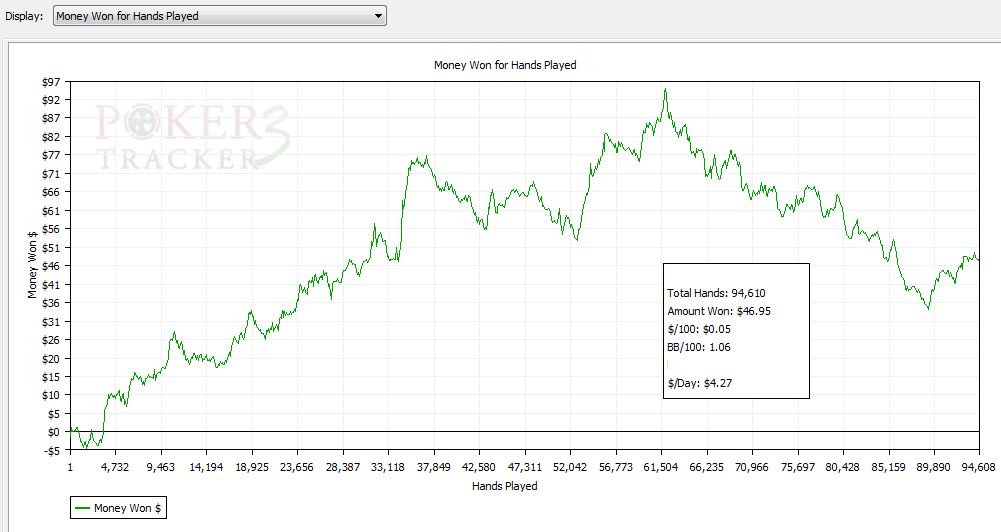Poker Variance
Professional poker players often describe their vocation as “a hard way to make an easy living”. One of the most difficult aspects of the game that a professional poker player must deal with is the inconsistency in income. Despite employing a strong skill set and the benefits of years of experience, many poker players still come home with less money in their pocket than when they arrived at the tables. These ups and downs of poker are often collectively known as “variance”.
What is Variance?
Video Poker Game Variance: What is variance? While we could go into the mathematical details we will explain variance on video poker machines using real world examples. Variance is one of the characteristics that makes a big difference in the short term results between one game and another. Lets compare two popular machines. It’s better to just embrace and more importantly understand the madness of variance than trying to avoid it. In reality, if you aren’t ready to deal with the variance of playing poker over a long stretch of time, then it just isn’t the game for you. Also just to note, variance is the root cause of. Variance is the downswings and upswings involved with playing poker. It’s quite possibly the least technical definition for a term I have ever written, but the “ups and downs” of poker when it comes to winning and losing money sums it up rather well. A sufficient poker bankroll is necessary to act as a cushion against variance. Some players may believe that, with just a few positive results at a $1/$2 no-limit hold’em game, they are ready to jump into a $2/$5 or $5/$10 game, regardless of their bankroll size.
In statistical terms, variance is used to examine the differences between an individual result and the average for a set of results. These results can be represented as data points in a set to determine the fluctuations within that set.
We’ll demonstrate how to calculate variance with a small sample data set. If you were to track the results for your previous sessions at a $3/$6 fixed-limit hold’em cash game, they could read:
-11, +85, -30, +144, +9, +30, -87
Each of these results represents a data point in a set of seven numbers.
The total of these seven sessions equals +140 (-11 + 85 – 30 + 144 + 9 + 30 – 87 = 140)
The average of these seven sessions equals +20 (140/7).
The variance is the sum of the squares of the differences between each data point and the mean.
For the first result, (20 – (-11)) = (20 + 11) = 31. 31^2 = 961
Follow the same procedure for each result and you get these corresponding numbers:
961, 4225, 2500, 15376, 121, 100, 11449
Add up these numbers and divide by seven to get the variance:
961 + 4225 + 2500 + 15376 + 121 + 100 + 11449 = 34732
34732/7 = 4961.71
The standard deviation, another measure of volatility, is the square root of the variance:
SQRT(4961.71) = 70.43
The most frequent results lie within one standard deviation (+/- 70) of the mean (+20). With these results, a player should expect to finish a session somewhere between -50 (20-70) and +90 (20+70).
However, many of these data points lie outside that range. Are these results the products of bad luck, bad cards or bad play?
Variance and Sample Sizes
The more data points a sample size contains, the more accurate and reliable the measurements of variance and standard deviation will be. The seven-point data set included here is obviously much too small to give an accurate estimate of how a player performs at a 3/6 limit hold’em game. Also, more data points will give the player more information on how to manage the inevitable ups and downs involved in cash games.
Variance and the Central Limit Theorem
Another important mathematical concept that comes with sample size is the “Central Limit Theorem”. This concept states that, as the number of data points in a set grows, a plot of those points on a graph will resemble a normal statistical distribution, as seen in the classic “Bell Curve”.
The guiding principle is that, the larger the sample size, the more data points that will fall at or near the average. This measure of variance gives the player a more accurate idea as to what to expect from his results.
Variance and Luck
Even in the most distinguished poker careers, a player will have sessions where he has wins (or losses) that go two or more standard deviations away from the average. Many inexperienced players attribute these results to luck, but they are within the realm of possibility shown in the Bell Curve. These data points are known as “outliers” and, individually, have little effect on the variance seen over a career. If these “outlying” results continue to appear, however, they may signal the start of a new trend.
Variance and Bankrolls

A sufficient poker bankroll is necessary to act as a cushion against variance. Some players may believe that, with just a few positive results at a $1/$2 no-limit hold’em game, they are ready to jump into a $2/$5 or $5/$10 game, regardless of their bankroll size. When the variance swings in the negative direction, as it inevitably will, a depleted bankroll could send the player to either a lower-stakes game or out of the game entirely.
Variance and Structure
Poker Variance Chart
Some poker games, as well as some betting structures, are prone to have higher variance than others. For instance, a $3/$6 fixed-limit hold’em game will have much less variance than a $1/$2 no-limit hold’em game due almost exclusively to the betting structure. In the $3/$6 limit game, the maximum bet a player can make on the river is $24 (bet-raise-re-raise-cap). In the no-limit game, a player can bet his entire stack at any time, which may be hundreds of dollars. These bet sizes can cause huge swings in variance.
Variance in Poker Tournaments
Despite the allure of fame and glory presented by televised events, no-limit hold’em tournaments are shining examples of the deceptive power of variance. Most professional players (including many famous faces on the tournament circuit) make more of their living through cash games and only enter the most prestigious (and lucrative) tournaments due to the high variance involved. Most major tournament winners are “outliers”, as up to ninety percent of all tournament players walk home empty-handed.
Variance and Playing Styles
In a previous piece, we examined the four primary playing styles (loose-passive, loose-aggressive, tight-passive and tight-aggressive). Just as the tight-aggressive style has been shown to be the most profitable, it also often results in the lowest variance. Both the loose-passive and the tight-passive players depend on catching cards to win hands (a high-variance strategy) while the loose-aggressive style relies on big bets to push players off hands. The tight-aggressive method relies on strong starting hand selection, infrequent bluffs and a well-founded understanding of probabilities, all of which contribute to reducing variance.
Variance and Emotion
The effects of big wins and staggering losses are not strictly limited to a player’s bankroll. The emotional roller coaster that comes with big swings in variance can also affect how a player approaches the game. Players who have become accustomed to big wins may lose their cool when confronted with a crushing loss. One bad session can set a player “on tilt” and wreck both his skills and his confidence.
Poker Tournament Variance
How to Deal with Variance
Shifts in variance can be as unpredictable and dangerous as shifts in the weather: everybody complains about them, but no one can do anything to prevent it. The most important aspect of success in poker lies in treating each session or tournament as a continuation in one long game. Experienced players understand that their success or failure as a player does not lie in the results of a single tournament or a handful of cash-game sessions. Each session represents only a single data point: a consistent approach will often reduce (but never entirely eliminate) variance.
Conclusion
Former World Series of Poker Main Event Champion Chris “Jesus” Ferguson once said that poker is “100 percent luck and 100 percent skill”. The turn of each card is the result of luck, but how a player responds to that unpredictable event is the product of skill, practice and experience. The ability to manage the game’s inherent variance is a skill on par with calculating odds and outs in terms of how successful a player can eventually become.
Related Lessons

By Gerald Hanks
Gerald Hanks is from Houston Texas, and has been playing poker since 2002. He has played cash games and no-limit hold’em tournaments at live venues all over the United States.
Poker Variance Calculator
Play Online Poker
We have tested and rated the best online poker sites and poker providers. All big poker providers have been tested in 12 categories and rated on a scale of 1 to 5.
Objective ranking of all big poker sites by their deposit bonus.
Official poker hands ranking overview with an explanation of which hand wins in Texas Hold’em. Including PDF overview for printing.
Overview of the most common poker probabilities and odds, including preflop odds, outs and formulas to calculate winning chances.
Poker Guides
ICM or “Independent Chip Model” is a method used to calculate the monetary value of chips in a poker tournament. This article explains how the ICM works.
When can I go all-in with a specific hand and how tight should I be in the push fold phase of a tournament? The Sklansky Chubukov tables provide a rudimentary answer to these questions.
When can you profitably go all-in with a hand? Which hands can you call an all-in with? Equilibrium pushbot charts help you develop good all-in ranges.
Chinese Poker rules, strategy and tips & tricks. This article explains how to play Chinese Poker, how to set hands and when to surrender.
Poker Tools
The cashgame variance calculator and simulator for poker is handy and easy to use. Just enter your winrate, standard deviation and the amount of hands to simulate. You’ll most certainly get insightful results.
The Poker Tournament Variance Simulator calculates variance for poker tournaments, MTTs and SNGs. Enter your tournament(s), hit calculate and let the simulator do its magic.
The Online Poker Rake Comparison and Rake Calculator shows how much rake players effectively pay when playing online poker cash games and which poker sites are the least and most expensive.
The pushbot trainer helps you to understand ranges in push-or-fold poker situations and visualizes the Sklansky Chubukov and Nash Equilibrium rankings.

The advanced ICM Deal Calculator can be used to determine ICM and chip chop distributions for deals in tournaments and simplifies poker tournament deal negotiations.
Other Tools & Stuff
How long does it take to achieve the legendary rank in Hearthstone? This handy simulator will answer to this question and show how long it will take to reach legendary depending on your win rate and your current rank.
Play Chinese Poker online against three AI players, analyse your play and find better strategies. This Chinese Poker App works in the browser and requires no download or registration.
Best Online Poker Sites
Check our online poker site comparison :